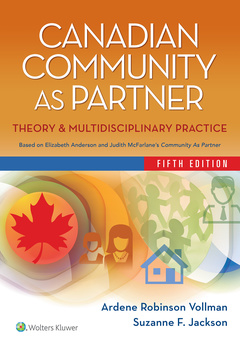Description
Canadian Community As Partner (5th Ed.)
Theory & Multidisciplinary Practice
Authors: Vollman Ardene Robinson, Jackson Suzanne F
Language: English
Subject for Canadian Community As Partner:
Prix indicatif 109,06 €
Disponible chez l'éditeur (délai d'approvisionnement : 14 jours).
Add to cart
Publication date: 02-2021
502 p. · 17.8x25.4 cm · Broché
502 p. · 17.8x25.4 cm · Broché
Canadian Community as Partner: Theory & Multidisciplinary Practice, 5th Edition, is an engaging introduction to the theoretical and practical foundations of successful Canadian community and population health. Valued by students and practicing nurses alike, this acclaimed text provides a comprehensive guide to community and public health nursing that satisfies the educational needs of today’s nursing students and helps tomorrow’s nurses confidently meet the unique challenges of caring for the Canadian public.
Addressing population health through the Canadian Community-as-Partner (CCAP) model, Canadian Community as Partner presents this multidisciplinary approach to community care from the ground up, establishing the theoretical foundations of community practice and taking students step by step through the processes of the CCAP model and its application to practice. Through unique case studies, authors Ardene Vollman and Suzanne Jackson provide concrete examples of how to effectively apply the Community-as-Partner model in a diverse range of real Canadian communities. This edition also features a wealth of visual aids that highlight core theoretical concepts and an array of exercises and activities that reinforce students’ ability to effectively apply what they’ve learned.
Addressing population health through the Canadian Community-as-Partner (CCAP) model, Canadian Community as Partner presents this multidisciplinary approach to community care from the ground up, establishing the theoretical foundations of community practice and taking students step by step through the processes of the CCAP model and its application to practice. Through unique case studies, authors Ardene Vollman and Suzanne Jackson provide concrete examples of how to effectively apply the Community-as-Partner model in a diverse range of real Canadian communities. This edition also features a wealth of visual aids that highlight core theoretical concepts and an array of exercises and activities that reinforce students’ ability to effectively apply what they’ve learned.
- UPDATED! Case studies drawn from real Canadian nursing practice demonstrate how to effectively apply the CCAP model across a diverse range of Canadian community and public health scenarios.
- UPDATED! An expanded array of teaching and learning resources — available on thePoint® — reduce class preparation time and keep students engaged.
- Diagrams, tables, and frameworks clarify core theoretical concepts.
- Learning Objectives keep students focused on the most important content.
- Take Note boxes alert students to key insights throughout the steps of the CCAP process, from assessment to evaluation.
- Critical Thinking Exercises throughout the text reinforce essential concepts and challenge students to apply their knowledge.
SECTION 1: Theoretical Foundations
Chapter 1 Population Health Promotion: Essentials and Essence of Practice
Chapter 2 Public Health in Canada
Chapter 3 Ethical Practice in Community Health
Chapter 4 Patterns of Health and Disease: The Role of Epidemiology in Population Health
Chapter 5 Strengthening Community Action: Public Engagement for Social Innovation and Collective Impact
Chapter 6 Developing Individual Skills: Building Capacity for Individual, Collective, and Sociopolitical Empowerment
Chapter 7 Creating Supportive Environments for Health: Enabling Community Action
Chapter 8 Reorienting Health Services: New Directions for Health Promotion
Chapter 9 Economic Thinking in Healthy Public Policy
Chapter 10 Social Justice and Equity for Health Promotion
Chapter 11 Negotiating the Cultural Context of Community Care
Chapter 12 Population Health Action: Prevention and Harm Reduction
Chapter 13 Community Mental Health Promotion
Chapter 14 Social Media and Health Promotion
SECTION 2: The Process of Community as Partner
Chapter 15 A Model to Guide Practice
Chapter 16 Community Assessment
Chapter 17 Community Analysis and Diagnosis
Chapter 18 Planning a Community Health Program
Chapter 19 Implementing a Community Health Program
Chapter 20 Evaluating a Community Health Program: Collaborative Action Evaluation
SECTION 3: Community as Partner in Practice
Chapter 21 Working With the Community Toward Food Security in Limoilou, Québec City
Chapter 22 Youth Engagement in Community Planning
Chapter 23 “Together Yet Living Apart”: Women Left Behind due to Labour Migration
Chapter 24 Flood Disaster Response: Calgary, Canada
Chapter 25 Promoting the Health of Newcomer Mothers to Manitoba
Chapter 26 Nunavut's Inunnguiniq Parenting Program
Chapter 27 Enhancing the Personal Skills of Service Providers to Promote the Sexual Health of Street-Involved Youth
Chapter 28 e-Health: Developing Personal Skills for Weight Management
Chapter 29 Hearing the Voices of Immigrant and Refugee Women for Planning Postpartum Depression Care
Chapter 30 Participatory Action Research: Mosque-Based Exercise for South Asian Muslim Women in Canada
Chapter 31 Best Practices in Early Childhood Development Programs in Newcomer Populations
Chapter 32 Influences on Quality of Life of Older Adults in a Remote Dene Community in the Northwest Territories of Canada
Chapter 33 Promoting the Health of Ethnic Women: Cervical Cancer Screening in a Sikh Community
Chapter 34 A Community College Dental Hygiene Program Supports Victoria's Underserved Population
Chapter 35 Influencing Food Security Through Mediating Public Policies: How It Works in Brazil
Chapter 36 Creating Healthy, Active Rural Communities Through Active Transportation
Chapter 37 Empowering Mothers of Murdered Children: A Community-Based Approach
Chapter 38 Cultural Continuity: Re-storying Identity of Indigenous Youth
© 2024 LAVOISIER S.A.S.




